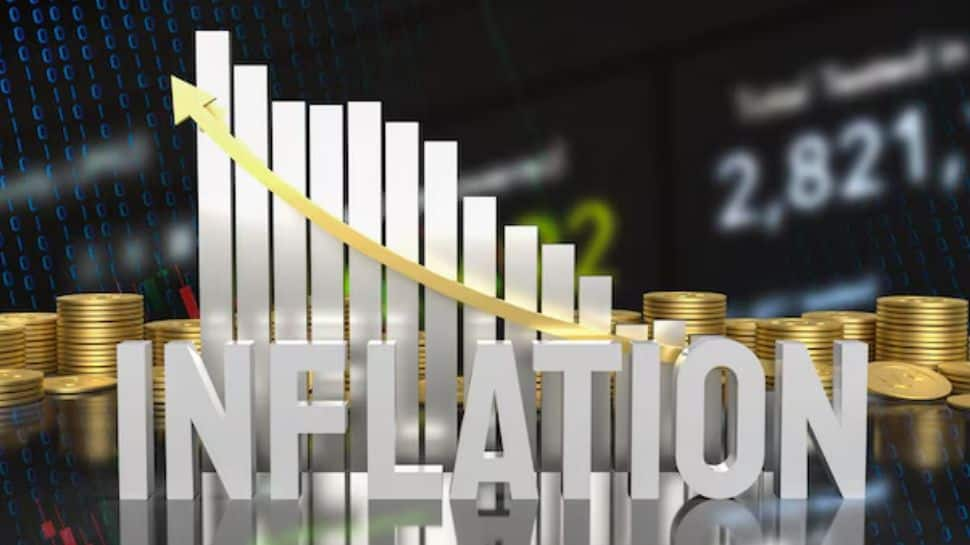Business
India’s Retail Inflation Likely To Ease Further In October: Report

New Delhi: India’s retail inflation is expected to fall further in October, supported by a high base effect, easing food prices, and the full impact of recent GST reforms, a new report has said. The data compiled by Union Bank of India suggests that inflationary pressures will only rise gradually in the coming months.
The bank said its projection for October’s Consumer Price Index (CPI) inflation is currently tracking below 0.50 per cent. It also expects food inflation to drop sharply and remain in the negative zone during the winter months, as the impact of recent floods has been limited.
Inflation has already eased to an eight-year low, helped by lower food prices and the rationalisation of GST rates. The report lowered its inflation forecast for FY26 to 2.6 per cent from the earlier estimate of 3.1 per cent.
It added that inflation is likely to stay below the RBI’s target range for most of the year and may rise slightly in the fourth quarter due to base effects. In September, CPI — which measures the average change in retail prices of goods and services –showed a notable decline compared to the previous month, highlighting a broad moderation in price growth.
The Consumer Food Price Index (CFPI) stood at -2.28 per cent, indicating that food prices have been falling since June 2025. Data also showed that inflation in rural areas was 1.07 per cent, while urban inflation was slightly higher at 2.04 per cent.
Food inflation remained negative in both segments, at -2.17 per cent in rural areas and -2.47 per cent in urban regions, reflecting the impact of falling prices of vegetables and edible oils. The government attributed this decline to “favourable base effects” and lower prices of key food items such as vegetables, oils, fruits, cereals, pulses, eggs, and fuel.
Economists believe that if the current trend continues, India could maintain a low-inflation environment through the festive and winter seasons, supporting consumer demand and overall economic stability.
Business
How To Apply For Insurance Claim After Accident? Where Does Licence Validity Come In? | Explained

Last Updated:
Even if your driving licence has expired, the law protects accident victims. Learn how insurance claims work and what the 30-day grace period covers
The rules for insurance claims following a road accident differ depending on whether it is a third-party claim or an own damage claim.
The Punjab and Haryana High Court has clarified that a driving licence remains valid for 30 days after its expiry. If an accident occurs on the 30th and final day of this grace period, the insurance company is legally required to honour the claim.
According to The Tribune, the licence in the case under consideration expired on June 4, 2001. The 30-day grace period began on June 5, meaning the licence remained valid until July 4, 2001. The accident took place on July 4, 2001, at around 10:45 am, and as it fell within the grace period, the licence was deemed legally valid.
Insurance Claims In India: What The Law Says
The rules for insurance claims following a road accident differ depending on whether it is a third-party claim or an own damage claim.
Third-Party Insurance: Mandatory for All Vehicles
Under Section 146 of the Motor Vehicles Act, 1988, third-party insurance is compulsory for every vehicle in India. Third-party claims relate to:
- Injury or death of a third party
- Damage to third-party property
The Supreme Court has consistently ruled that even if the driver has no licence, an expired licence, a suspended licence or a licence of the wrong category, the insurance company must still compensate the victim or their family.
This obligation remains even if:
- The driver has no driving licence at all
- The licence has expired
- The licence is suspended
- The licence belongs to an incorrect vehicle category
- The driver only holds a learner’s licence
‘Pay and Recover’ Principle
The Supreme Court frequently applies the pay and recover principle:
- The insurer must first pay compensation to the victim.
- The insurer may then recover the amount from the vehicle owner.
In 2023, the Supreme Court reaffirmed that the victim must not suffer because the driver lacked a valid licence.
Own Damage Claims: Strict Rules Apply
The rules for own damage claims are entirely different. Every motor insurance policy clearly states that the driver must have:
- A valid driving licence
- A proper licence for the vehicle category
If, at the time of the accident:
- The driver had no licence, or
- The licence had expired, or
- The licence was not appropriate for that vehicle,
the insurance company will reject the own damage claim entirely.
This position was upheld by the Supreme Court in Dharmendra Goyal vs Reliance General Insurance (2022) and reaffirmed in multiple judgements between 2023 and 2025.
The National Consumer Commission (NCDRC) issued similar rulings in dozens of cases.
Grace Period And Licence Validity
If an accident occurs within the 30-day grace period after the licence has expired, insurance policies provide full coverage, both for:
- Third-party claims, and
- Own damage claims
This rule is applicable nationwide.
When Is Renewal Necessary?
According to Section 15 of the Motor Vehicles Act, 1988 and the Central Motor Vehicles Rules, 1989:
30-Day Grace Period
- The licence remains fully valid for 30 days after expiry.
- There is no penalty if renewed within these 30 days.
Penalties After The Grace Period
- After 30 days: Rs 300 fine, increasing to Rs 1,000 per year.
- After 1 year: The applicant must take the driving test again.
- After 5 years: A complete restart is required, including a new learner’s licence.
Renewal Made Easier (2025 Guidelines)
The Ministry of Transport’s 2025 guidelines confirm:
- The 30-day grace period applies across India.
- Driving licences can be renewed instantly online via the Parivahan.gov.in portal.
December 08, 2025, 14:12 IST
Read More
Business
IndiGo Shares Sink Over 6.5% Amid Ongoing Flight Disruptions

Mumbai: Shares of InterGlobe Aviation, the parent company of IndiGo Airlines, fell sharply in early trade on Monday, dropping 6.6 per cent to an intra-day low of Rs 5,015 on the BSE.
However, it recovered later as around 9:45 a.m., the shares were trading at Rs 5,159.50, down by Rs 211 or 3.93 per cent.
The sell-off came after the Directorate General of Civil Aviation (DGCA) extended the deadline for IndiGo CEO Pieter Elbers to respond to a show-cause notice linked to the airline’s recent operational disruptions.
The aviation regulator had issued a show-cause notice to IndiGo’s accountable manager on Sunday, just a day after sending a similar notice to CEO Pieter Elbers.
The DGCA said that the airline’s massive wave of cancellations over the past week caused widespread inconvenience and distress to passengers across the country.
According to the regulator, the disruptions were largely triggered by IndiGo’s failure to plan properly for the rollout of the revised Flight Duty Time Limitations (FDTL) rules.
These rules, which lay down the duty hours and mandatory rest periods for flight crew, came into effect recently and have created significant operational challenges for the airline.
In its notice, the DGCA pointed out that IndiGo’s “large-scale operation failures” suggest major lapses in planning, oversight and resource management.
The accountable manager has been given 24 hours to explain why enforcement action should not be taken. If the airline fails to respond within the extended deadline, the DGCA has said it will proceed based on the information available.
Even as the regulatory pressure increases, IndiGo said on Sunday that it has restored 95 per cent of its network and plans to operate around 1,500 flights.
The airline claimed that its operations are on track to stabilise by December 10, with improving on-time performance and fewer cancellations.
However, more than 220 flights had already been cancelled across major airports by the time of reporting, adding to the inconvenience faced by thousands of passengers.
Business
Trump raises potential concerns over $72bn Netflix-Warner Bros deal

US President Donald Trump has flagged potential concerns over Netflix’s planned $72bn (£54bn) deal to buy Warner Brothers Discovery’s movie studio and popular HBO streaming networks.
At an event in Washington DC on Sunday, he said Netflix has a “big market share” and the firms’ combined size “could be a problem”.
On Friday, the two companies said they had reached an agreement that could bring Warner Brothers’ franchises like Harry Potter and Game of Thrones to Netflix, creating a new media giant.
The planned deal, which has raised concerns among some in the industry, is yet to be approved by competition authorities. The BBC has contacted Warner Brothers, Netflix and the White House for comment.
Launched in 1997 as a postal DVD rental business, Netflix has grown to become the world’s largest subscription streaming service. The deal – the biggest the film industry has seen in a long time – would cement its number one position.
Under the agreement several global entertainment franchises, such as Looney Tunes, The Matrix and Lord of the Rings, would move to Netflix.
The US Justice Department’s competition division, which oversees major mergers, could contend that the deal violates the law if the combined businesses account for too much of the streaming market.
At an event at the John F. Kennedy Center in the US capital, Trump said that Netflix has a “very big market share” which would “go up by a lot” if the deal goes ahead.
Trump added that he would be personally involved in the decision on whether or not to approve the deal and repeatedly highlighted the size of Netflix’s market share.
He also said that Netflix’s co-CEO Ted Sarandos recently visited the Oval Office and praised him for his work at the company.
“I have a lot of respect for him. He’s a great person,” said Trump. “He’s done one of the greatest jobs in the history of movies.”
Mr Sarandos earlier acknowledged that the agreement may have surprised investors but said it was a chance to position Netflix for success in the “decades to come”.
Some in the entertainment industry have criticised the agreement.
The Writers Guild of America’s East and West branches called for the merger to be blocked, saying the “world’s largest streaming company swallowing one of its biggest competitors is what antitrust laws were designed to prevent.”
“The outcome would eliminate jobs, push down wages, worsen conditions for all entertainment workers, raise prices for consumers and reduce the volume and diversity of content for all viewers,” it said on Friday.
-

 Tech1 week ago
Tech1 week agoGet Your Steps In From Your Home Office With This Walking Pad—On Sale This Week
-

 Sports1 week ago
Sports1 week agoIndia Triumphs Over South Africa in First ODI Thanks to Kohli’s Heroics – SUCH TV
-

 Entertainment1 week ago
Entertainment1 week agoSadie Sink talks about the future of Max in ‘Stranger Things’
-

 Fashion1 week ago
Fashion1 week agoResults are in: US Black Friday store visits down, e-visits up, apparel shines
-

 Politics1 week ago
Politics1 week agoElon Musk reveals partner’s half-Indian roots, son’s middle name ‘Sekhar’
-

 Tech1 week ago
Tech1 week agoPrague’s City Center Sparkles, Buzzes, and Burns at the Signal Festival
-

 Sports1 week ago
Sports1 week agoBroncos secure thrilling OT victory over Commanders behind clutch performances
-

 Sports1 week ago
Sports1 week agoF1 set for final-race showdown as Verstappen exploits McLaren blunder | The Express Tribune







